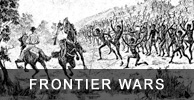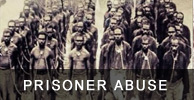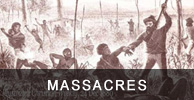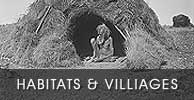Frontier History Revisited - Colonial Queensland
Frontier History Revisited - Colonial Queensland and the 'History War' by Robert Ørsted-Jensen, 278 pp, Lux Mundi Publishing, Brisbane, 2011, ISBN 9781466386822, c$27.00.

BUY BOOK HERE
ANU Review by Tim Bottoms 2012
This book has been precisely written as a thorough rebuttal of K Windschuttle's work. It is not simply incidentally attacking him at various points. It has been written to knock him off his perch, and it succeeds. It is a political history of colonial Queensland dealing with black and white relations and the colony's parliamentary history as well as the key players, both inside and outside of parliament including the press. Ørsted-Jensen flags a further three volumes of work, yet to be published, entitled The Right to Live, which delve into the foundation of frontier policy, frontier policy and political dissent, and struggling for change of policy.
Frontier History Revisited certainly packs a punch. There are five chapters, the first: 'Queensland and Australian Colonial History' is critical of the paucity of studies and analysis of early Australian colonial histories, and in particular that of Queensland, which is identified as sporadic and inconsistent. This, even to the extent that 'on certain issues [they are] almost non-existent'. Unpalatable though this might be to some, one cannot help but agree that generations of Australian historians, with some notable exceptions, have accepted earlier written works and appear to assume that they do not need re-assessment. This is a pivotal criticism, which rightly singles them out as being in need of exposure to more 'critical evaluation'. In contrast, the primary sources tell a completely different story - one that is genuinely more honest and elucidates events in a way that cannot be done with the earlier secondary sources. Jonathan Richards has also noted this flaw (Richards 2008: 6). It is an important observation about Australian historiography.
Similarly the work deals with issues relating to the pre-occupation by previous Australian historians with patriotic nation-building that embraces a biased approach rather than allowing one 'to reflect and judge on what always will remain the core issues in human history, namely the struggles, sufferings, welfare and rights of all mankind' (p. 4). This perspective is a breath of fresh air that carries over into the rest of the book. Ørsted-Jensen goes on to identify that many of the white people who criticised the policy of violence on the frontier had in fact also participated in some way with the carnage. Next he contextualises the population of Indigenous Queensland in relation to the rest of the colonies of Australia and their pre and post contact numbers, as well as recognising the impact of at least two major smallpox epidemics. From the research of Butlin and then Prentis, the author concludes that Queensland had the highest Aboriginal population at 37.9 per cent that he notes is: 'the only possibility to rationally explain the Queensland colonial experience' (p. 15). That is, the formidable resistance and largest massacres of white settlers in Australia (Hornet Bank and Cullin-la-Ringo), as well as the longest serving Native Police service (51 years, 1859-c1910), and the highest estimates and more frequent references to violence. There is also a consideration of casualty figures that confirms Queensland's pre-eminence in this unsavoury record of killing. In 'Accusations and Denials', Ørsted-Jensen considers the campaign against the 'black armband mode of history' and effectively deconstructs the denialist viewpoint with stunning veracity.
Chapter 2, 'Fact or Fabrication?' deals with an array of topics initially related to words and phrases brought up in the 'history war', such as 'dispersal', 'invasion', 'guerilla war' and 'war of extermination'. Under the sub-heading of 'Retribution Ratio' innumerable examples are given where the ratio of killings (black to white) vary greatly, from the conservative Reynolds/Loos ratio of 10:1, to 12:0, 25:0, 47:0, 59:3, 17:1, 29:1, 30:0, 60:0 and 50:1. The research here is compelling as each story behind the ratio is given and sources from which they have been derived cited so that the historical proof is particularly creditable. An unfortunate aspect is that these examples appear to be just the tip of the iceberg. Then there is a consideration of the class of officer who served in the Native Police and how it was not seen as necessary to perform body counts of the numerous 'collisions'. Under the sub-heading 'Forensic Evidence' Ørsted-Jensen tackles the absurdities of Windschuttle's method of argument and persuasively demolishes them using evidence from the primary sources. The discussion about Blagden Chambers' (1836-1943) Black and White - the story of a massacre and its aftermath, originally published between 1926 and 1927 and dealing with the late 1860s,1 enables an insightful assessment of frontier violence to haunt the reader. The poisoning episodes of Kilcoy and Whiteside stations are also examined and their unpleasant ramifications considered. The chapter concludes with an evaluation of how white attitudes on the frontier hardened from the 1850s and into the 1880s.
Chapter 3, 'The Purging of the Evidence' looks at the deliberate obfuscation by the colonial government about the recording of 'the number of blacks captured, wounded or killed, and the number of murders and other outrages committed by the blacks' (p. 93) between 1 January 1865 and 25 April 1866 .2 While the question was accepted in the Queensland Legislative Assembly, it was never answered, or when it was the Premier lied. Then the official reporting system by the Native Police is identified and it is apparent that officers were to be discrete about what they and their troopers did on their dispersals far from the public eye. Here, once again, Ørsted-Jensen has discerned further methods of hiding the truth of Native Police operations when he identifies a system of double book-keeping where there was an official diary record and another for internal use. The last component of this chapter deals with the destruction of records and they are identified as having been very systematically, deliberately and comprehensively destroyed. Some reports survived because they were filed in other departments, but as the author notes they were cleansed of details that should have been there because of established directives. This effectively contradicts Jonathan Richards' belief that the archives tells us everything we need to know and that official records have not been purposely destroyed. They had.
Chapter 4, 'The Myth of Missionary Prominence' is a detailed assessment of the role missionaries played in the propagation of the so-called 'Exeter Hall' objection to the treatment of Aborigines and effectively demonstrates that missionaries did not really begin their influence until the last decade of the nineteenth century. This contradicts Windschuttle's claim that they were supposedly instrumental in falsely exaggerating the violence on the frontier.
Chapter 5, 'Conclusionary Notes' wraps up further inordinately false or grossly misleading claims by denialists and identifies a much more rational interpretation regarding frontier violence. The fallacies propagated are shown to be just that. Ørsted-Jensen considers the falsehood of denying past governments for policies regarding the treatment and control of Indigenous Queenslanders and blaming foreign influences for these aspects. The uncovering of primary source documents which clearly identify the Executive Council and Governor's involvement in directing the Native Police is truly significant. This in conjunction with his discussion of death toll estimates is illuminating, and far more convincing than anything purported by Windschuttle and his fellow denialists.
Appendix A gives a listing of the death toll of the invader that coherently substantiates the author's interpretation. This includes a comprehensively detailed breakdown from 1827 to 1900 with a concluding summary. Appendix B is a thought provoking analysis of what happened to 'The Lost Native Police Reports'. In a common sense manner the file categories at the Queensland State Archives are assessed. From this comes the remarkable fact that 'only 10 percent of all our file volume is from the actual Police Department and 47 percent is from the minister's office!?' (p. 256). Ørsted-Jensen's argument that the Native Police files had been seriously culled is very convincing and the Appendices are a valuable contribution to Queensland historical research.
However, it is rather disappointing that a professional publishing editor was not used to smooth over some of the more awkward English phrasing that detracts from the flow of the work. It is apparent that Ørsted-Jensen is not a native English speaker and one wonders how the work got to the stage of publishing without this aspect being remedied. This is unfortunate as his research and ideas are truly exceptional. On a similar level, the frequent use of the phrase 'as we shall see' is somewhat irritating and might have been better to eliminate or varied by re-phrasing. Lastly, Yarrabah Mission was set up at Cape Grafton, not at Bellenden Ker (p. 146), which is some 40 kilometres to the south (see Bottoms 2002: 237-239, 278; Halse 1992: 57 passim). However, these points are relatively insignificant when considering the comprehensive scope and thorough coverage that the author has achieved.
This is truly an excellent and refreshing work in the world of Australian historical writing. The author argues:
Good historians are supposed to allow the material they uncover to influence them, they are not supposed to carefully select and massage the evidence to fit some political or ideological position of the present. Windschuttle does the latter, he has carefully picked the weak and insufficiently argued points in the body of work of what he clearly from the very beginning classified as his 'political opponents', and rather than carefully investigate and apply some unbiased scholarship and analysis, and thus attempt to mend such gap in our knowledge, he went on to prey on it. He simply commenced to twist and spin-doctor on the evidence he had in front of him, for the purpose of some specific political interests and positions of the present (p. 166).
One cannot help but agree. Frontier History Revisited is an extremely valuable contribution in understanding colonial Queensland and sets a very high standard in historical research. This work is a 'tour de force' and is a 'must have' for those wanting to understand the colonial machinations of Queensland's early politicians and is a damning indictment on those contemporary critics who would deny the true extent of brutality on Queensland's colonial frontier.
References
Bottoms, T 2002, 'A History of Cairns - City of the South Pacific, 1770-1995', unpublished PhD thesis, Central Queensland University.
Halse, C 1992, 'The Reverend Ernest Gribble and Race Relations in Northern Australia', unpublished PhD thesis, University of Queensland.
Ørsted-Jensen, R 2011, Frontier History Revisited, Lux Mundi Publishing, Brisbane.
Richards, J 2008, The Secret War, University of Queensland Press, St Lucia.
Tim Bottoms
Cairns
1 In serial form in Country Life, New South Wales.
2 Ørsted-Jensen, Frontier History Revisited, p.93; Queensland Parliamentary Debates, Legislative Assembly, 25 April 1866, as reported in the Brisbane Courier 26 April 1866 and Queenslander 28 April 1866.






